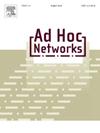认知地空协同边缘计算网络中的自组织任务卸载与资源分配
IF 4.8
3区 计算机科学
Q1 COMPUTER SCIENCE, INFORMATION SYSTEMS
引用次数: 0
摘要
将无人机基站(DBS)、移动边缘计算(MEC)和认知无线电集成到地面网络中,有可能满足日益增长的计算需求。这种网络被视为认知空地协同移动计算(CAGC-MEC)网络。然而,考虑到物联网(IoT)网络的大规模和动态特性,传统的集中式方法具有令人望而却步的复杂性,可扩展性可能会大打折扣。本文研究了自组织任务卸载和资源分配方法,以最大限度地提高物联网的体验质量(QoE)。我们提出了 DBS 部署、资源分配、任务卸载和信道选择方案的联合优化问题。按照先覆盖后优化的方法,我们提出了一种基于局部 Voronoi 分区的部署方法,以提高覆盖率。在此基础上,我们推导出资源分配方案的闭式表达式。随后,分别用拉格朗日对偶分解法和最佳响应法解决了任务卸载和信道选择子问题。提出的算法可以在物联网位置未知且没有中央控制器的条件下执行。大量仿真验证了所提出的算法优于其他基准算法。本文章由计算机程序翻译,如有差异,请以英文原文为准。
Self-organized task offloading and resource allocation in cognitive air-ground collaborative edge computing networks
The integration of drone base stations (DBSs), mobile edge computing (MEC), and cognitive radio into the terrestrial network has the potential to address the ever-growing computing demands. Such networks are regarded as cognitive air-ground collaborative mobile computing (CAGC-MEC) networks. However, considering the large-scale and dynamic features of the Internet of Things (IoT) network, the traditional centralized method possesses prohibitive complexity, and the scalability may be compromised. This paper investigates the self-organized task offloading and resource allocation methods to maximize the quality of experience (QoE) of IoTs, which is evaluated by mean opinion score (MOS). We formulate a joint optimization problem of DBS deployment, resource allocation, task offloading, and channel selection schemes. Following the coverage then optimization methodology, a local Voronoi partition-based deployment method is proposed to improve the coverage rate. On this basis, we derive the closed-form expression of the resource allocation scheme. Subsequently, the task offloading and channel selection sub-problems are solved by Lagrange dual decomposition and best response methods, respectively. The proposed algorithm can be executed under the conditions that the positions of IoTs are previously unknown and without a central controller. Extensive simulations verify that the proposed algorithm is superior to other benchmark algorithms.
求助全文
通过发布文献求助,成功后即可免费获取论文全文。
去求助
来源期刊

Ad Hoc Networks
工程技术-电信学
CiteScore
10.20
自引率
4.20%
发文量
131
审稿时长
4.8 months
期刊介绍:
The Ad Hoc Networks is an international and archival journal providing a publication vehicle for complete coverage of all topics of interest to those involved in ad hoc and sensor networking areas. The Ad Hoc Networks considers original, high quality and unpublished contributions addressing all aspects of ad hoc and sensor networks. Specific areas of interest include, but are not limited to:
Mobile and Wireless Ad Hoc Networks
Sensor Networks
Wireless Local and Personal Area Networks
Home Networks
Ad Hoc Networks of Autonomous Intelligent Systems
Novel Architectures for Ad Hoc and Sensor Networks
Self-organizing Network Architectures and Protocols
Transport Layer Protocols
Routing protocols (unicast, multicast, geocast, etc.)
Media Access Control Techniques
Error Control Schemes
Power-Aware, Low-Power and Energy-Efficient Designs
Synchronization and Scheduling Issues
Mobility Management
Mobility-Tolerant Communication Protocols
Location Tracking and Location-based Services
Resource and Information Management
Security and Fault-Tolerance Issues
Hardware and Software Platforms, Systems, and Testbeds
Experimental and Prototype Results
Quality-of-Service Issues
Cross-Layer Interactions
Scalability Issues
Performance Analysis and Simulation of Protocols.
 求助内容:
求助内容: 应助结果提醒方式:
应助结果提醒方式:


